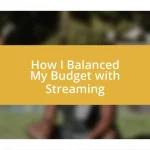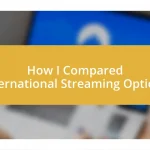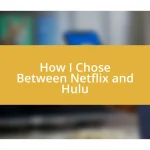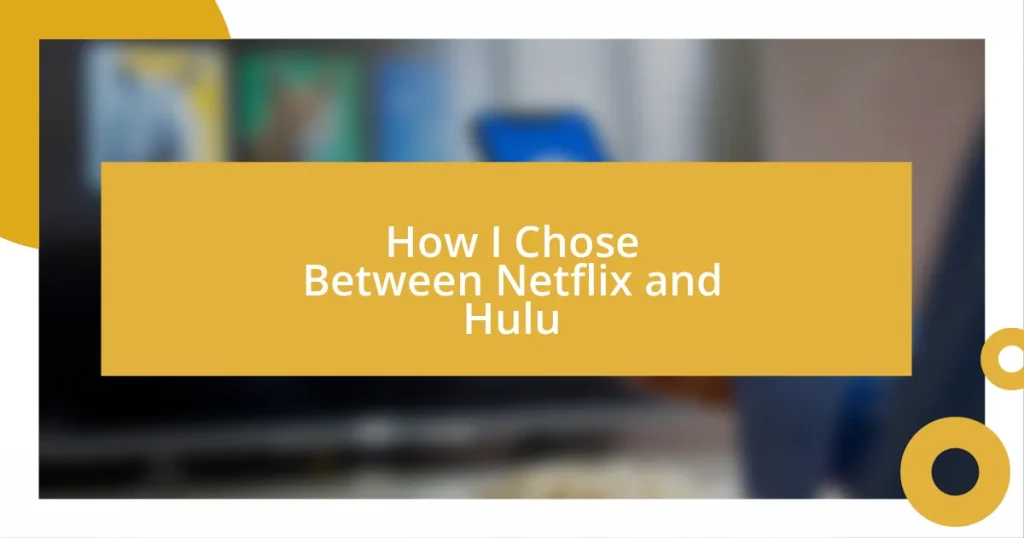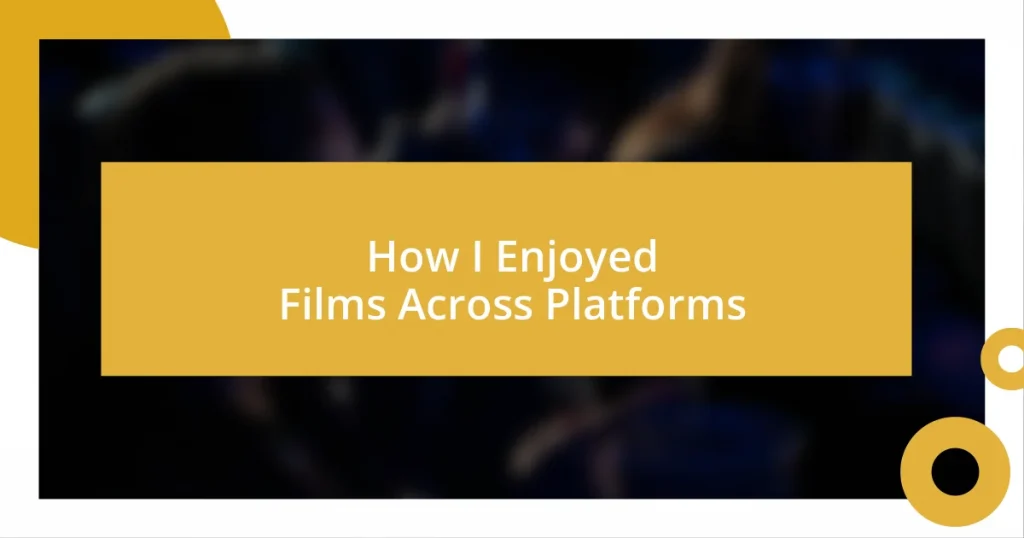Key takeaways:
- The decision between Netflix and Hulu was influenced by the desire for diverse content, emotional connections with shows, and the balance between quality and quantity.
- Netflix’s user interface and personalization features provided a more enjoyable experience compared to Hulu’s sometimes cluttered navigation and less tailored suggestions.
- Ultimately, the choice of Netflix was driven by its immersive storytelling and the emotional bonds formed with its original content, despite Hulu’s appealing features like next-day access to popular TV shows.
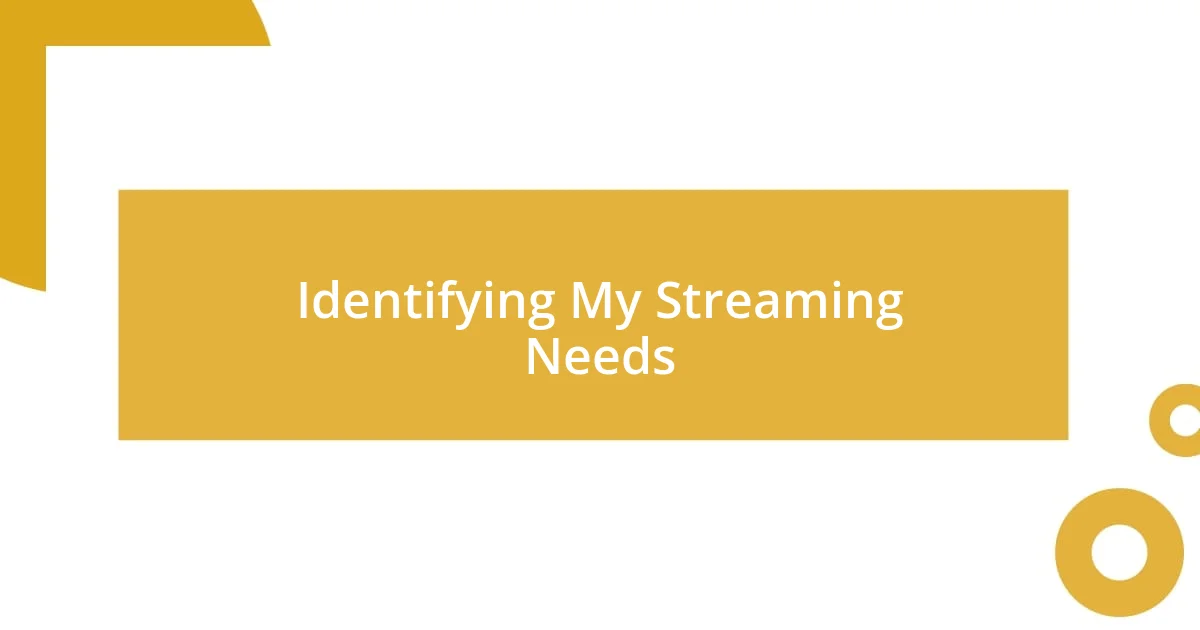
Identifying My Streaming Needs
When I first started thinking about my streaming options, I really had to dig deep into what I wanted to watch. I remember sitting on my couch one evening, binge-watching a documentary, and realizing that I crave diverse content—not just movies, but also original series and informative shows. This led me to wonder: was I looking for quantity, quality, or a mix of both?
I appreciate a platform that offers not just the latest films but also the classics that resonate with me personally. For instance, there’s something comforting about revisiting favorite episodes of old sitcoms. Does that emotional connection matter to you? For me, it’s a significant factor—it’s like visiting old friends each time.
Moreover, I had to reflect on my viewing habits. Am I someone who enjoys watching alone or do I often gather friends for movie nights? I recall a weekend when I hosted a get-together, and we sprawled on the floor, laughter echoing as we scrolled through various options. It became clear that I needed a streaming service with a robust library that caters to group viewing while still offering enough variety for my solo nights.
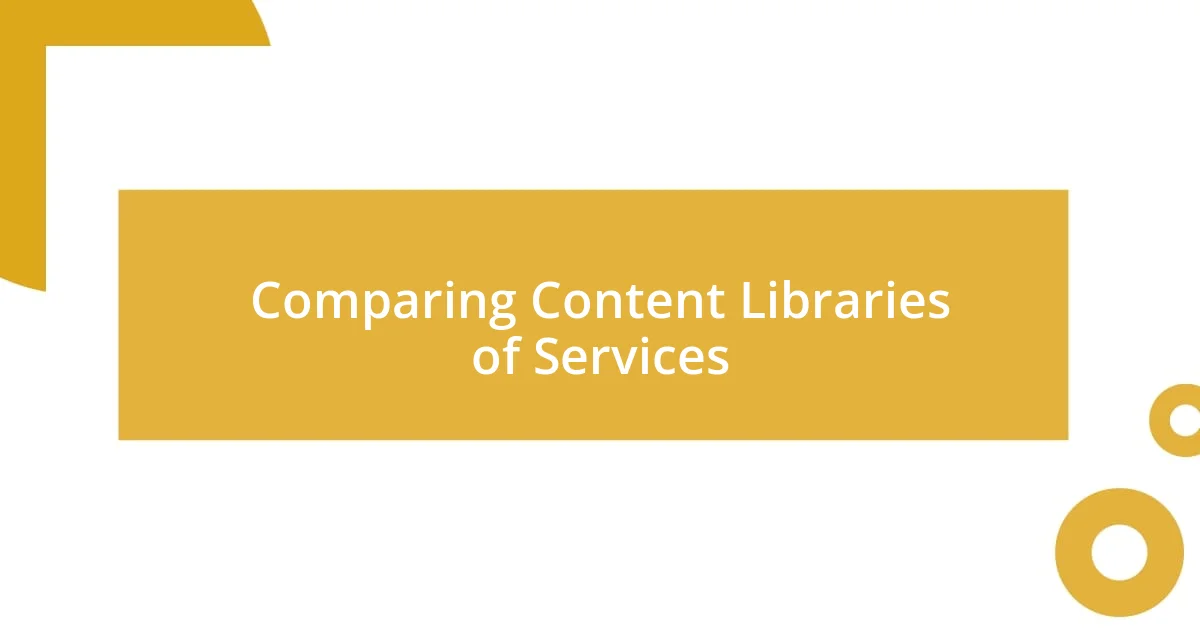
Comparing Content Libraries of Services
When comparing the content libraries of Netflix and Hulu, one of the first things that struck me was the sheer volume of options available on each platform. Netflix seemed to have a wider array of original programming, including gripping dramas and feel-good comedies that I often found myself recommending to friends. On the other hand, Hulu impressed me with its robust selection of current TV shows, allowing me to catch up on my favorites like “The Handmaid’s Tale” and discover hidden gems I hadn’t heard about.
Here’s a quick breakdown that really showcases this contrast:
-
Netflix:
- Extensive collection of original films and series
- Strong focus on international content
- Abundant documentaries and specialized programming
-
Hulu:
- Access to next-day episodes of popular TV shows
- A rich library of vintage series and classic films
- Variety of channels available for live viewing
Reflecting on my own viewing habits, I realized that this diversity is crucial. One night, I sat down with a glass of wine ready to dive into a new drama, but then I found myself doing a happy dance when I discovered my favorite ‘90s sitcoms on Hulu. That nostalgia was a game changer for me, proving that sometimes, it’s not just about new content but also the ability to revisit beloved classics.
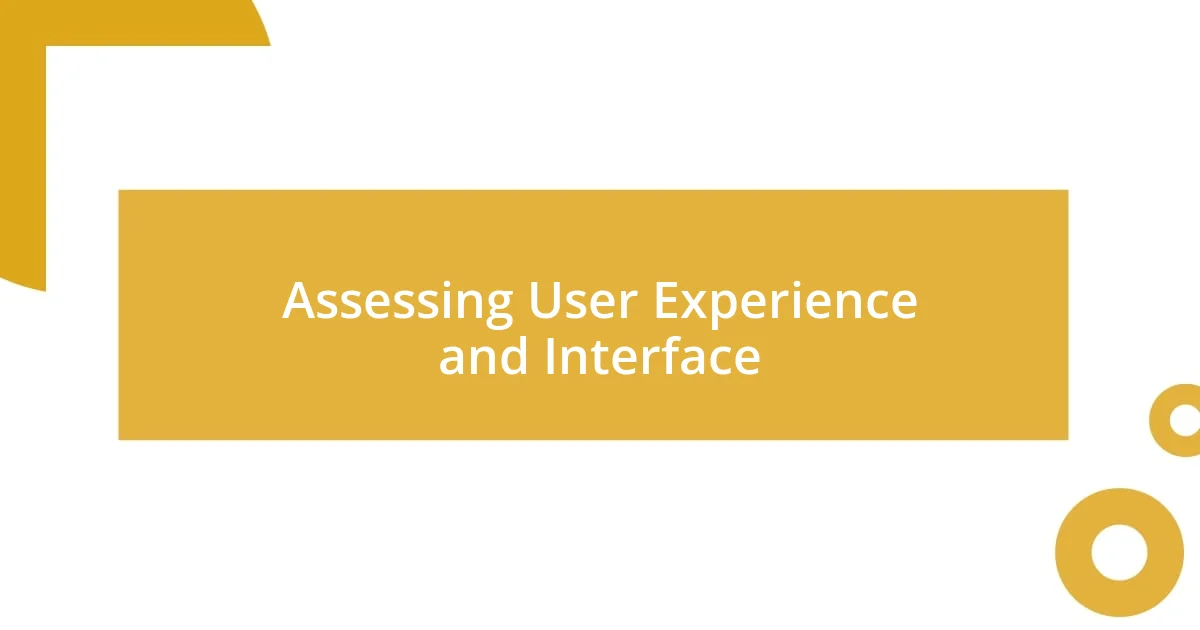
Assessing User Experience and Interface
When I explored the user experience of both Netflix and Hulu, I quickly noticed the stark differences in their interfaces. Netflix’s layout struck me as sleek and visually appealing, making it easy to find what I wanted to watch without overwhelming options. One evening, I sat down to binge a series with a few friends, and we found ourselves diving right into the thumbnails, each one enticing us to click. Hulu, however, felt cluttered at times, especially when I wanted to access a specific show. Navigating through its library sometimes felt like searching for a needle in a haystack.
What really caught my attention was how both platforms approach personalization. Netflix’s algorithm does an impressive job of suggesting shows based on my viewing history, and I’m often surprised by how accurate its recommendations are. I remember the last weekend when it suggested a little-known documentary that turned out to be a delightful watch—it was so intriguing that I ended up discussing it with a friend the next day. Alternatively, Hulu’s suggestions seem less tailored to my preferences, which made me occasionally scroll through options that didn’t resonate with my tastes as much.
Lastly, I can’t overlook the impact of accessibility and ease of use. With Netflix, I felt comfortable settling in, laptop in hand, because the mobile-friendly interface allowed seamless transitions from my TV to my tablet without missing a beat. In contrast, I had a moment of frustration when trying to resume my series on Hulu, as my progress wasn’t syncing across devices. I found myself thinking about how little nuisances like this can affect the overall enjoyment of streaming—a thought that lingered in my mind when weighing my decision.
| Netflix | Hulu | |
|---|---|---|
| User Interface | Sleek and visually appealing | Cluttered at times |
| Personalization | Accurate recommendations | Less tailored suggestions |
| Device Accessibility | Seamless transitions | Inconsistent progress syncing |

Evaluating Pricing and Subscription Plans
When I dived into the pricing and subscription plans of Netflix and Hulu, it felt like I was comparing apples to oranges, and I had to consider what I truly valued in a streaming service. Netflix offers a straightforward pricing model with its tiers—basic, standard, and premium. I remember feeling relieved not to be overwhelmed by hidden fees or promotional deals that made budgeting unpredictable. It was comforting to know exactly what I would pay each month.
Hulu, on the other hand, caught my attention with its flexibility. The option for a lower-cost ad-supported plan made me wonder, “Am I willing to trade some convenience for savings?” I admit I was tempted, especially since Hulu often has current episodes of my favorite shows. However, I also considered how those commercials would interrupt my viewing flow. I once had a binge-watching session interrupted by ads, and it felt like a mood-killer—definitely something I wanted to avoid during those cozy nights on the couch.
Ultimately, as I assessed the total value of what I’d get for my money, I leaned toward the plan that resonated most with my lifestyle. It was enlightening to realize that sometimes the cheapest option might not be the best fit. I found myself asking, “What really matters in my viewing experience?” For me, it was about finding quality content at a predictable price.

Exploring Additional Features and Perks
While exploring additional features and perks, I realized how much extra value can sway my streaming decision. For instance, Netflix offers a download option that has come in handy during long flights. I remember one time, stuck on a plane with no Wi-Fi, I happily dove into a complete season of my favorite series, creating a little oasis of entertainment amidst the discomfort of cramped seating. Could there be a better way to escape when you’re thousands of feet up?
On the flip side, Hulu’s next-day access to current episodes of popular TV shows really stood out to me. I think back to when I was anxiously waiting to catch the latest episode of a drama I was hooked on—Hulu had it available for streaming almost immediately after airing. That urgency to stay in the loop felt crucial, especially as I discussed plot twists with friends who also tuned in. It made me wonder, how often do we crave that instant gratification when it comes to entertainment?
One of the most surprising perks from both platforms was the inclusion of special content. Netflix often features behind-the-scenes documentaries and interviews that offer insight into creative processes. I fondly recall watching a making-of feature for a series I loved, which deepened my appreciation for the show. Meanwhile, Hulu occasionally runs curated collections featuring specific actors or themes, which opened up a world of watchlists I had never considered before. I found it intriguing how a simple bonus feature could lead to discovering hidden gems, enriching my overall viewing journey.
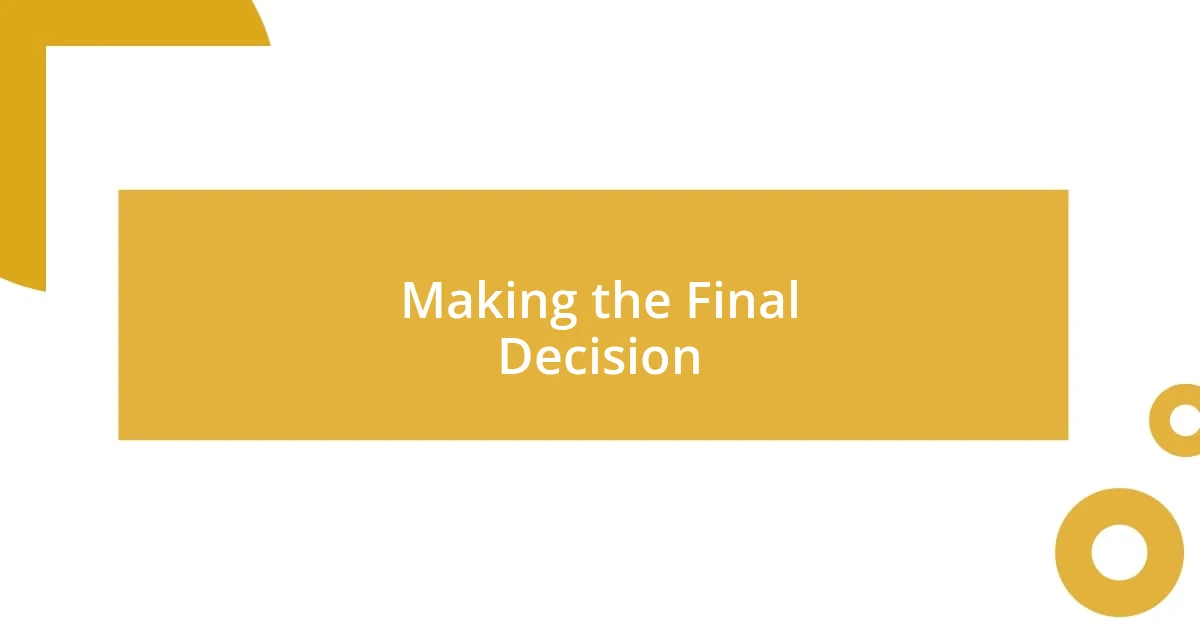
Making the Final Decision
As I sat down to finally make my decision, a myriad of factors swirled through my mind. I found myself wondering, “What do I truly seek in my streaming experience?” For me, the balance of quality content versus sheer quantity stood out. I still vividly recall a night spent debating myself—my smart TV ready to go, and my popcorn waiting—while images of Netflix’s iconic original shows danced in my mind versus Hulu’s tempting line-up of current TV dramas. It was a tie between nostalgia and novelty.
Reflecting on my viewing habits was crucial. I realized the times I usually turned to streaming were often during quiet evenings or lazy weekends. Those moments had a certain magic to them—cozying up on the couch, blanket draped around me, ready to escape into another world. Did I want the deep immersion Netflix offered, or the lively immediacy of Hulu’s timely episodes to spark conversations the next day? This personal touch made the decision feel heavier; I wasn’t just choosing a service, but shaping my entertainment routine.
In the end, my final decision pulled me toward Netflix, largely driven by its reputation for delivering binge-worthy series that immersed me in different narratives. I thought back to how many late nights I lost track of time because a show grabbed my attention and wouldn’t let go. That immersive experience was what swayed me—that emotional connection with the stories mattered more than just having the latest episodes right away. It became clear that, for me, the depth of the content triumphs over immediacy every time.
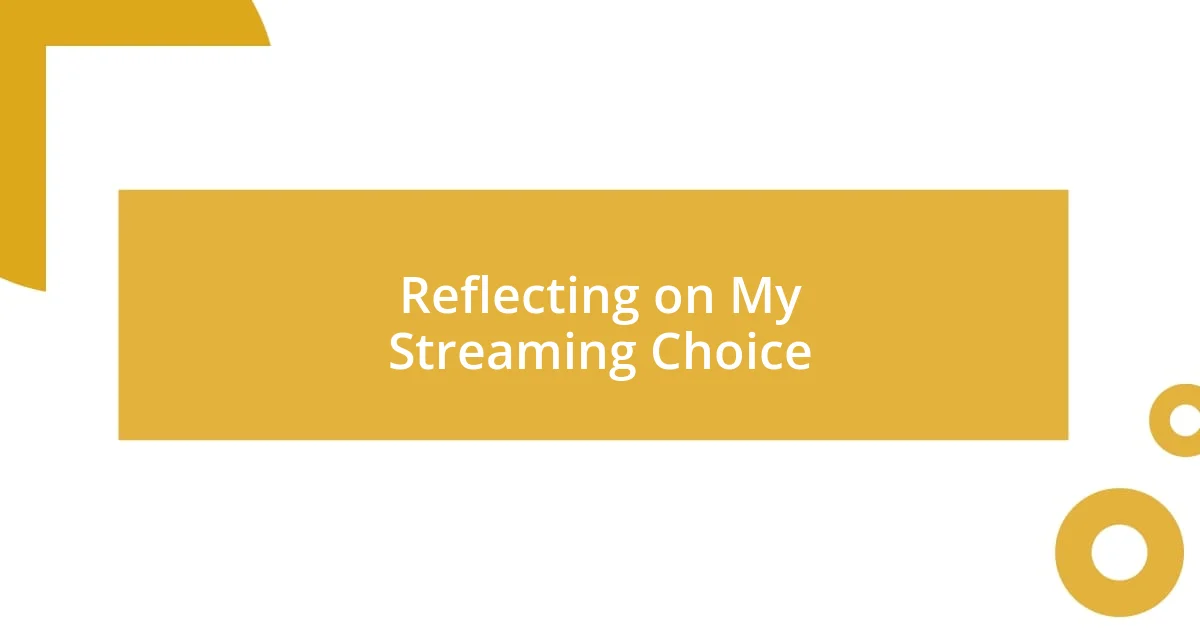
Reflecting on My Streaming Choice
Reflecting on my streaming choice, I couldn’t help but think about the countless hours I spent exploring the available libraries. Each weeknight, I found myself scrolling through the vast options, drawn into trailers and descriptions that often led to spirals of indecision. I remember one particular evening when I was torn between starting a highly-rated Netflix original or diving into a trending sitcom on Hulu. Have you ever felt that magnetic pull to just launch into the next binge-worthy series? It’s a familiar tug-of-war that stemmed from what I valued most in my viewing experience.
I also recall the emotional connection I forged with certain shows. One Netflix series resonated with me on a deeper level, reminding me of my own journey. As I watched the characters face challenges, I found myself whispering words of encouragement, as if I were part of their world. Have you ever felt like a character was speaking directly to you? This kind of connection became a significant factor in my streaming decision, influencing me to lean toward a platform that nurtured that kind of storytelling.
Ultimately, reflecting on moments of joy, laughter, and even tears I shared with these shows helped clarify my choice. The memories of cozy weekend marathons, where the world outside faded away, stood out vividly. Do you remember the last time you lost track of time because a show had you hooked? Each platform offers something unique, but for me, the ability to connect emotionally with content became my guiding light in deciding, making Netflix resonate more profoundly with my viewing life.



